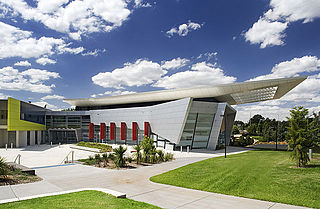
The Powerhouse Museum, formerly known as the Museum of Applied Arts & Sciences (MAAS), is a collection of museums in Sydney, and owned by the Government of New South Wales. Its main centre is in Ultimo, New South Wales, the others being the historic Sydney Observatory at Observatory Hill, and the newer Powerhouse Castle Hill at Castle Hill. Powerhouse Parramatta is due to open in 2025.
Casula is a suburb of Sydney, in the state of New South Wales, Australia. It is 34 kilometres south-west of the Sydney central business district, in the local government area of the City of Liverpool.
The Blake Prize, formerly the Blake Prize for Religious Art, is an Australian art prize awarded for art that explores spirituality. Since the inaugural prize in 1951, the prize was awarded annually from 1951 to 2015, and since 2016 has been awarded biennially.

Artspace, officially Artspace Visual Arts Centre, is an independent, not-for-profit and non-collecting residency-based contemporary art centre. Artspace is housed in the historic Gunnery Building in Woolloomooloo, fronting Sydney Harbour in Sydney, Australia. Devoted to the development of certain new ideas and practices in contemporary art and culture, since the early 1980s Artspace has been building a critical context for Australian and international artists, curators and writers.

The National Art School (NAS) is a tertiary level art school, located in Darlinghurst, an inner-city suburb of Sydney, New South Wales, Australia. The school is an independent accredited higher education provider offering specialised study in studio arts practice across various disciplines.
Marion Borgelt is a contemporary Australian artist based in Sydney. Borgelt originally trained as a painter and now her practice encompasses painting, installation, sculpture and mixed media. With a career spanning over 40 years, she has held more than 50 solo exhibitions and participated in over 180 group shows globally. Borgelt's work is currently held in public collections including the National Gallery of Australia and Sydney's Museum of Contemporary Art, and in international museums such as Los Angeles County Museum of Art, USA and New Zealand's Auckland Art Gallery Toi o Tāmaki.

Campbelltown Arts Centre is a multidisciplinary contemporary arts centre located in Campbelltown, New South Wales, south west of Sydney, Australia. It is a cultural facility of Campbelltown City Council, assisted by other government funding and private sponsorships.
The Blake Poetry Prize is an Australian poetry prize for a new work of 100 lines or less, focused on non-sectarian spiritual and religious topics, connected to the Blake Prize, an art prize. The prize, worth A$5,000, is presented biennially by the Casula Powerhouse Arts Centre (CPAC) in conjunction with the bookshop Westwords.
Carlos Barrios is a Salvadoran-Australian artist.

Robert Hague, is an Australian artist living and working in Melbourne, Victoria. He is best known for his metal and marble sculpture and his detailed lithographic print work.
Patricia Larter (1936–1996) was an Australian artist who worked across mail art, video, photography, performance and painting. She was "one of the leading figures in the movement known as 'international mail art'". She is credited with coining the term "femail art" that was taken up by other mail artists around the world.

Karma Phuntsok is a Tibetan painter.
Lisa Havilah is the CEO of the Museum of Applied Arts and Sciences (MAAS) in Sydney, Australia. She has previously directed various arts centres in Sydney, including Carriageworks and Campbelltown Arts Centre.
Eugenia Raskopoulos is a contemporary artist notable for her photographic and video work critiquing language, processes of translation, and the body. Raskopoulos' work has been shown in numerous Australian and International exhibitions, and was the winner of the Josephine Ulrick and Win Schubert Award for her work Vestiges #3, 2010.
Raquel Ormella is an Australian artist focusing on multimedia works such as posters, banners, videography and needlework. Ormella’s work has been showcased in many exhibitions in galleries and museums, including the Shepparton Art Museum and the Art Gallery of New South Wales. Working in Sydney and Canberra, Ormella’s pieces are known to encompass themes of activism and social issues in many forms and has received praise.

Head On Photo Festival is an international annual photography festival based in Sydney, Australia, showing emerging and established photo-artists. It was founded in 2004 by Moshe Rosenzveig OAM with the first Head On Portrait Award. The Festival is held across multiple venues, including public and commercial galleries as well as public outdoor spaces.

In Mandaeism, a shkinta or shkina (škina) is a celestial dwelling inhabited by uthras in the World of Light that is analogous to the shekhinah in Jewish mysticism. In Tibil, it refers to a reed or mud hut that is used during Mandaean priest initiation ceremonies, since Mandaean priests represent uthras on earth.

Mandaean Australians are Australians of Mandaean descent or Mandaeans who have Australian citizenship.
Sue Pedley is an Australian multi-media artist known for site-specific artworks in Australia and overseas. She has participated in residencies including the Bundanon Trust Creative Research Residency in 2016, the Tokyo Wonder Site in 2012, and the 2008 International Sculpture Symposium, Vietnam. Pedley works solo and in collaboration with other artists.
Yuhana Nashmi is an Iraqi-Australian visual artist and ceramicist.










